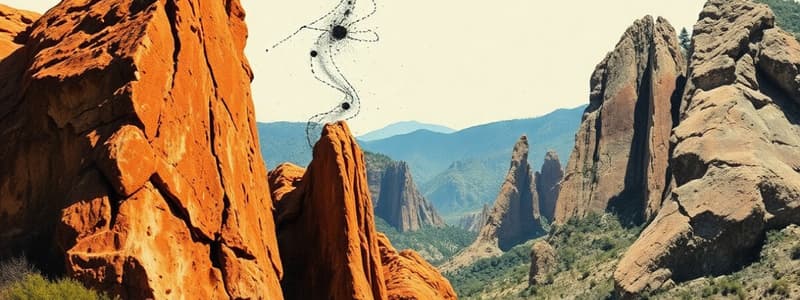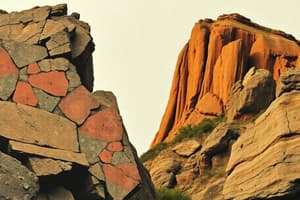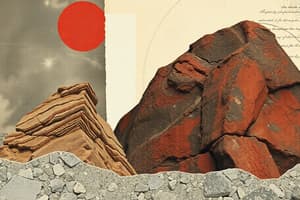Podcast
Questions and Answers
Which of the following statements is TRUE about the rock cycle?
Which of the following statements is TRUE about the rock cycle?
- The rock cycle follows a strict order, transitioning from igneous to sedimentary to metamorphic rocks.
- The rock cycle is primarily driven by the force of gravity.
- The rock cycle is a continuous process where rocks can transition between different types in various ways. (correct)
- The rock cycle only occurs in the Earth's crust and does not involve the mantle.
What is the process called when sediment is compacted and cemented together to form sedimentary rock?
What is the process called when sediment is compacted and cemented together to form sedimentary rock?
- Lithification (correct)
- Erosion
- Weathering
- Metamorphism
Which of the following is a key characteristic of metamorphic rocks?
Which of the following is a key characteristic of metamorphic rocks?
- They are formed by the cooling and solidification of magma.
- They are always found at the Earth's surface.
- They are composed of primarily broken-down fragments of preexisting rocks.
- They often exhibit a distinct layered or banded structure. (correct)
What type of rock forms from the cooling and solidification of magma?
What type of rock forms from the cooling and solidification of magma?
What type of rock is formed when existing rocks are weathered, eroded, transported, and then compacted and cemented together?
What type of rock is formed when existing rocks are weathered, eroded, transported, and then compacted and cemented together?
Which of these is NOT a key characteristic of sedimentary rocks?
Which of these is NOT a key characteristic of sedimentary rocks?
What type of weathering breaks down rocks into smaller pieces without changing their chemical composition?
What type of weathering breaks down rocks into smaller pieces without changing their chemical composition?
Which of the following sedimentary rock types is formed from clay-sized particles?
Which of the following sedimentary rock types is formed from clay-sized particles?
Which of the following is NOT a process involved in the formation of clastic sedimentary rocks?
Which of the following is NOT a process involved in the formation of clastic sedimentary rocks?
Which of the following is NOT a factor that directly influences metamorphic changes?
Which of the following is NOT a factor that directly influences metamorphic changes?
Which type of metamorphism occurs at convergent plate boundaries?
Which type of metamorphism occurs at convergent plate boundaries?
Which of the following metamorphic rocks is characterized by a distinct layered structure called foliation?
Which of the following metamorphic rocks is characterized by a distinct layered structure called foliation?
Which of the following metamorphic rocks is formed from the metamorphism of limestone?
Which of the following metamorphic rocks is formed from the metamorphism of limestone?
Which of the following processes contributes to the high pressures necessary for metamorphism?
Which of the following processes contributes to the high pressures necessary for metamorphism?
Which of the following metamorphic rocks is considered a low-grade metamorphic rock?
Which of the following metamorphic rocks is considered a low-grade metamorphic rock?
Which of the following is a common characteristic of metamorphic rocks?
Which of the following is a common characteristic of metamorphic rocks?
The metamorphic process that occurs when rocks are in contact with a heat source is called:
The metamorphic process that occurs when rocks are in contact with a heat source is called:
Which of the following is an example of a non-foliated metamorphic rock?
Which of the following is an example of a non-foliated metamorphic rock?
What is the primary role of weathering and erosion in the rock cycle?
What is the primary role of weathering and erosion in the rock cycle?
Which of the following is NOT a condition necessary for the formation of metamorphic rocks?
Which of the following is NOT a condition necessary for the formation of metamorphic rocks?
What is the connection between the Rock Cycle and the differing ages of rocks based on their location?
What is the connection between the Rock Cycle and the differing ages of rocks based on their location?
What is the main reason why dinosaurs are considered a common symbol for the ancient past?
What is the main reason why dinosaurs are considered a common symbol for the ancient past?
Which of the following best describes the primary source of oil?
Which of the following best describes the primary source of oil?
Study Notes
The Rock Cycle
- The rock cycle is a continuous process, not a linear one.
- Rocks can transform into other types of rocks through various processes.
- Three main types of rocks exist: igneous, sedimentary, and metamorphic.
- The cycle can proceed in any order.
- Extreme heat and pressure can turn rocks into magma.
- Rocks can transform repeatedly throughout the cycle.
- Oceanic crust is the youngest, getting progressively older toward the continent's interior.
- The rock cycle describes how material in the three basic rock types changes and moves.
- Rock ages reflect their location relative to the center of a continent.
- Oil is not made from dinosaurs; it is a myth. Oil comes from decayed marine organisms, primarily microscopic phytoplankton.
Rock Types
- Igneous rocks: Formed from cooled magma.
- Sedimentary rocks: Formed from compacted and cemented sediment.
- Metamorphic rocks: Formed from pre-existing rocks under high heat and pressure.
- Formed when existing rocks (igneous, sedimentary, or other metamorphic rocks) change physically or chemically.
- Changes occur in the solid state, not melting.
- Often host economic mineral deposits.
- Common bedrock type in North America.
- Basalt is a common igneous rock.
- Limestone and marble are sedimentary/metamorphic rock examples.
- Clastic sedimentary rocks: Formed from pre-existing rocks that have been weathered and eroded.
- Chemical sedimentary rocks: Formed from dissolved minerals in water.
- Biochemical/organic sedimentary rocks: Formed in areas with high biological activity.
- Examples include coquina (shells), chalk (microscopic organisms), and coal (dead plants).
Formation Pathways
- Igneous to Sedimentary: Igneous rocks weather and erode into sediment, which then compacts to form sedimentary rocks.
- Sedimentary to Metamorphic: Sedimentary rocks, or igneous rocks, buried deeply experience heat and pressure, transforming them into metamorphic rocks.
- Metamorphic to Igneous: Metamorphic rocks exposed to high temperatures can melt back into magma, which, when cooled, becomes igneous rocks.
- Metamorphic to Metamorphic: Metamorphic rocks can experience further metamorphism.
- Sedimentary to Igneous (or Metamorphic): Sedimentary rocks can also be subjected to intense heat and pressure, becoming either metamorphic or igneous rocks.
- Igneous to Metamorphic: Igneous rocks can also be altered by high heat and pressure into metamorphic rocks.
- Subduction Zones: Plates collide; high heat and pressure transform rocks into both metamorphic and igneous rocks. Oceanic crust subducts beneath continental crust. Metamorphic and sedimentary rocks accumulate as accretionary wedges.
- Mid-ocean Ridges: New igneous crust forms as oceanic plates spread apart, creating new igneous rock.
- Limestone to Marble: Limestone can turn to marble through metamorphic processes.
Processes
- Weathering and Erosion: Break down of rocks into sediment. Types include physical and chemical weathering.
- Compaction: Pressure on sediment causing particles to become tightly packed.
- Cementation: Minerals bind the sediment particles together.
- Lithification: The combination of compaction and cementation.
- Melting: Rocks are melted into magma.
- Cooling: Magma cools to form igneous rock.
- Heat and Pressure: Forces that transform rocks into metamorphic rocks.
- Key factor in metamorphic changes.
- Requires a "window" between approximately 200-800 degrees Celsius.
- Temperatures too high cause melting, forming igneous rocks.
- Temperatures too low prevent necessary reactions.
- Increases with depth. Deep burial, plate tectonic processes, proximity to magma contribute.
- Hot fluids play a role.
- Subduction Zones: Plates collide, leading to metamorphism, recycling of oceanic crust.
- Mid-ocean Ridges: Formation of new igneous crust.
- Lithification: The combination of compaction and cementation.
- Sedimentary rocks have layers because of variations in deposition energy during formation (e.g. floods, seasonal changes)
Rock Characteristics
- Igneous rocks: Crystalline structure.
- Sedimentary rocks: Composed of cemented sediment (often with visible fragments and layers); may contain fossils.
- Metamorphic rocks: Often display foliation (squiggly lines) due to pressure-induced mineral alignment; may exhibit banding.
- Formed from existing rocks undergoing physical or chemical change due to temperature, pressure, or fluids.
- Clastic sedimentary rocks: Form from various sizes of sediments (clasts); from tiny clay particles to large boulders. Sediment size determines the rock name (e.g., shale, siltstone, sandstone, conglomerate, breccia).
- Chemical sedimentary rocks: Form from dissolved minerals in water; include limestone, rock salt.
- Biochemical or organic sedimentary rocks: Form in areas with high biological activity; include coquina (shells), chalk (microscopic organisms), and coal (dead plants).
- Accretionary wedges form when sediments and rocks are scraped off subducting plates, contributing to the growth of continents.
Important Details
- Sedimentary rocks can form in bodies of water; layers form due to variations in deposition energy (e.g., floods, seasonal changes in lakes).
- Layers of sediment build up, with lower layers becoming compacted under higher layers.
- Common cementing minerals include calcite and quartz.
- Conglomerate has rounded clasts, breccia has angular clasts.
- Energy levels needed to transport different sediment sizes (sand>silt>clay).
- Different depositional environments yield different layers of sediment.
Metamorphic Processes
- Temperature:
- Key factor, window between approximately 200-800 degrees Celsius.
- Temperatures too high cause melting, forming igneous rocks.
- Temperatures too low prevent necessary reactions.
- Pressure:
- Increases with depth in Earth's crust. Deep burial, plate tectonic processes, and proximity to magma all contribute to high pressures.
- Fluids:
- Hot fluids significantly impact metamorphic changes.
Types of Metamorphism
- Contact Metamorphism:
- Occurs when rocks are in contact with a heat source, such as a magma chamber.
- Changes the rock's texture and mineralogy.
- Regional Metamorphism:
- Associated with plate boundaries, particularly convergent boundaries where plates collide.
- High temperatures and pressures at convergent boundaries lead to high-grade metamorphism.
- Descending plates experience lower temperatures and high pressures, resulting in low-grade metamorphism.
- Oceanic ridges, with high temperatures and circulating fluids, also experience metamorphism.
Recognizing Metamorphic Rocks
- Foliation:
- Many metamorphic rocks display a layered or sheet-like structure called foliation.
- Minerals align perpendicular to pressure direction.
- Formation often associated with regional metamorphism.
- Non-Foliated Rocks:
- Some metamorphic rocks lack foliation.
- This occurs when the original rock lacked minerals aligning easily. Examples are quartzite (metamorphosed sandstone) and marble (metamorphosed limestone).
Examples of Metamorphic Rocks
- Foliated Rocks:
- Slate: Low-grade metamorphic rock from shale.
- Phyllite: Higher-grade than slate, with a sheen.
- Schist: Higher-grade than phyllite, with distinct foliation and larger mineral grains.
- Gneiss: Highest-grade, characterized by distinct mineral banding.
- Non-Foliated Rocks:
- Quartzite: Metamorphosed sandstone, hard and resistant.
- Marble: Metamorphosed limestone, often used for decoration.
Summary
- Metamorphism changes rock composition and texture in the solid state.
- Driven primarily by temperature and pressure changes.
- Common types are contact metamorphism (magma) and regional metamorphism (plate boundaries).
- Continents grow through accretion of terranes, including rocks formed in subduction zones.
- Oil is not derived from dinosaurs, but from tiny marine organisms like phytoplankton.
Studying That Suits You
Use AI to generate personalized quizzes and flashcards to suit your learning preferences.




